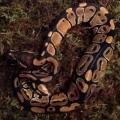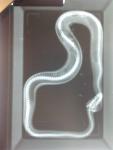» Site Navigation

1 members and 1,320 guests
Most users ever online was 47,180, 07-16-2025 at 05:30 PM.
» Today's Birthdays

» Stats

Members: 75,924
Threads: 249,127
Posts: 2,572,249
Top Poster: JLC (31,651)
Welcome to our newest member, Lenori
|
-
Registered User


HELP! What type of lizard is this?

I know it's a bad picture, but the lizard is approximately two inches wide by 6 inches in length. I have to know what it eats, my friend's dad found it in his store and he's not sure if it's native to Washington or not.
-
-
Registered User


If it is native to Washington here are the possibilities of what it could be.
http://www.burkemuseum.org/herpetology/reptiles
0.1 Ball Python
0.1 Colombian Red Tail Boa
0.1.2 Gargoyle Gecko
-
The Following User Says Thank You to abrunsen For This Useful Post:
-
Registered User


Re: HELP! What type of lizard is this?
It kind of looks like an anole, I'm not sure though but the feet remind me of one.
Could be a sagebrush lizard but it doesn't really have a pattern.  Maybe someone lost an anole? My friend's dad found it in his store. Maybe someone lost an anole? My friend's dad found it in his store.
-
-
Registered User


I don't know much about lizards but I thought it looked a lot like an anole. What kind of store does he own?
0.1 Ball Python
0.1 Colombian Red Tail Boa
0.1.2 Gargoyle Gecko
-
The Following User Says Thank You to abrunsen For This Useful Post:
-
Registered User


Re: HELP! What type of lizard is this?
He works at a retail store. lol.
Is it possible it's a brown anole? Can green anoles turn brown? I don't really know much about them.
Last edited by Miko; 11-01-2011 at 08:08 PM.
-
-
see if it has a dewlap under its chin. that will be a dead giveaway. males have larger ones and the females have smaller ones but still have one.
1.0 Bumblebee, 1.0 Super Pastel, 1.0 Cinnamon, 1.0 Mojave, 1.0 Yellowbelly, 0.1 Pinstripe, 0.1 Pastel 50% het Caramel, 0.1 Spider, 0.1 Normal, 0.2 het albino, 0.1 possible het red dinker, 1.1 CH granite dinkers 1.0 Woma
1.0 Hypo BCI, 0.1 Hypo BCI (25% BCC) 66% het Anery, 0.1 Guyana BCC, 0.1 Cay Caulkers Boa, 0.1 Dumerils Boa 0.1 Anery BCI
0.1 Black Blood Python, 1.0 Irian Jaya Carpet Python, 0.1 Jaguar Coastal Carpet Python 1.1 Jungle Carpet Python 1.0 Tiger Coastal Carpet Python 0.1 Coastal Carpet Python
1.0 Argentine Black and White Tegu 0.0.1 Savannah Monitor 1.0 Hypo Citrus Pastel Beardie 0.0.1 Frilled Dragon 0.4 Leopard Geckos 1.0 Albino Black Rat Snake
0.1 Russian Tortoise 0.0.1 Golden Gecko
-
The Following User Says Thank You to Reakt20 For This Useful Post:
-
Yes, green anoles can be brown. They turn to blend in with their surroundings although the change is no where near what chameleons can do of course. They'll be brown most of the time in fact and usually are only bright green during mating season.
It looks like a common anole to me - sometimes the toes get very long like you see here. They are not native to Washington although California is a distinct possibility - it could've somehow hitched a ride up north, lol. Most likely it escaped from someone's home and made its way into your dad's store. Are you going to keep it? They are easy to care for - just make sure that its diet does not consist only of crickets. Those have too much exoskeleton and they need more soft-bodied insects. They are neat little lizards. 
Last edited by Evenstar; 11-01-2011 at 10:07 PM.
-
The Following User Says Thank You to Evenstar For This Useful Post:
Skittles1101 (11-05-2011)
-
BPnet Veteran


Re: HELP! What type of lizard is this?
It is an Anole. They are not native to Washington. They are native to the southern subtropical regions of North America and the Carribean Islands. There a several different types of Anole. The only Anole that is actually native to North America is the American or Green Anole. They can change color from green to brown. Alot depends on temperature, stress, hormonal activity(breeding season). The males will display a colorful dewlap under his chin to entice females or warn off competing males from there territory. The females can lay eggs 2-3 times per year. Chances are that it is an escapee. They need good humidity and do best kept in a planted terrarium. Small crickets are good but do need a wide variety of insects for food including soft bodied prey items as posted already. They should be misted as they do not drink from a bowl very well, they prefer to lap dew from the leaves of live plants. Good luck with him. You will know if he is not kept warm enough when you see him turn almost black in color.
4.11.3 Normals, 1.1 Fire, 0.1 spider, 0.3 Pastel, 1.0 Super Cinny, 0.1 Cinny, 1.1 pinstripe, 1.1 Mojave, 1.0 Firefly, 1.3 Yellowbellies, 1.2 Het. Pied, 1.0 Pied, 1.0 Mystic, 0.1 Pinstripe het. Albinoo, 0.1 Lesser het. Albino, 1.1 Enchi, 1.0 Calico Pastel, 0.1 Calico, 0.1 Sable, 0.1 Vanilla, 1.1 VPI Axanthic, 0.1 het. VPI Axanthic, 0.1 het. Clown, 1.0 Bumblebee, 0.1 Orange Ghost, 1.0 Champaign, 1.0 Albino, 0.1 het. Albino, 1.1 Black Pastel, 1.1 Dumerils, 1.1 BCI, 1.0 ATB, 1.0 Childrens Python, 3.2.1 Bearded Dragons, 0.0.1 Timor Monitor
Welcome to the zoo.
-
The Following User Says Thank You to Reesy For This Useful Post:
-
Looks like an Anole to me as well.
0.1.0 Normal Ball Python 2.0.0 BCI ?
1.0.0 Western Hognose 0.0.1 Albino Tangerine Honduran Milk Snake
0.1.0 Rosy Boa 0.1.0 Snow Motley Corn snake
0.0.1 Honduran Milk Snake 0.1.0 Gray Banded King Snake
2.0.0 Okeetee Corn Snakes 0.1.0 Apricot Pueblan Milk snake
0.0.1 Anery Corn Snake 1.2.0 Hog Island Boas
1.1.0 Colombian Rainbow Boa 0.1.0 Nicaraguan Boa
0.1.0 California King Snake 1.0.0 Solomon Island ground Boa
1.1.0 Amelanistic Nelson's Milk Snake 0.1.0 Sunglow Boa
0.0.1 Guyanan Red Tail
-
 Posting Permissions
Posting Permissions
- You may not post new threads
- You may not post replies
- You may not post attachments
- You may not edit your posts
-
Forum Rules
|